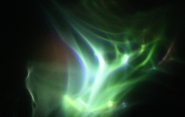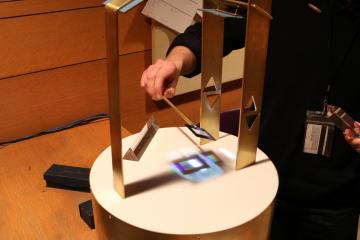Engineering And Art Meet At Two Museums

If there are still any doubts about engineering’s contributions to the arts, two museum exhibits should put those to rest.

Both the Yale Center for British Art (YCBA) and the Yale University Art Gallery (YUAG), have incorporated student projects borne out of Engineering Innovation & Design (ENAS 118), to complement ongoing exhibits that opened recently.
At the YCBA on Chapel Street are two projects connected to the museum’s exhibit, “Enlightened Princesses: Caroline, Augusta, Charlotte and the Shaping of the Modern World,” about three German princesses who married into the British royal family in the 18th century and had a significant influence on science and the arts around the world.

The three princesses promoted some of the greatest minds of their day, including Isaac Newton, whose 1704 book, “Opticks: or a Treatise of the Reflections, Refractions, Inflections, and Colours of Light,” is featured in the exhibit. The work is dense with technical detail, which makes conveying its cultural impact to visitors something of a challenge. Tyler Griffith, a postdoctoral research associate at the YCBA and one of the organizers of the exhibit, noted that you can only do so much with labels and text. He talked about possible solutions with the co-teachers of ENAS 118, Larry Wilen, mentor and senior research scientist at the Center for Engineering Innovation & Design (CEID), and Vincent Wilczynski, deputy dean of the School of Engineering and Applied Science. Bringing Newton’s laws of light to life became one of the design challenges of the course last semester.
Working in the CEID’s Klingenstein Design Lab, two student teams each developed models demonstrating Newton’s theories. One model emphasized interactive learning, while the other nodded toward Newton’s flair for showmanship with an artistic, sculpture-like model. Using mirrors and prisms, these models put into action Newton’s laws on refraction, reflection and diffraction.
“They’re based on the students’ readings of “Opticks,” Griffith said. “We’re very happy with how these turned out.”
For more information, go to "Enlightened Princesses: Caroline, Augusta, Charlotte and the Shaping of the Modern World.”

On the other side of the street, at the Yale University Art Gallery, are two other projects of CEID origin. These are from the previous year’s Engineering Innovation & Design course. The two projects are connected to the museum’s new exhibit, “Lumia: Thomas Wilfred and the Art of Light” – the first exhibition devoted to Wilfred in more than 40 years. The Danish-born American artist forged a new kind of art, which he deemed “Lumia,” made from mechanical sculptures that produced vibrant, multi-colored displays.
Although he once enjoyed a status equal to Mark Rothko, Jackson Pollock and other contemporaries, Wilfred’s reputation has faded since his death in 1968, partly due to the difficulty of putting his works on display. That's because much of the technology he used has fallen into obsolescence. The logistics of restoring the works and getting them in working order for the YUAG exhibit was a years-long process fraught with numerous complications.
The exhibit’s curators praised the student projects for illustrating the physical and mechanical aspects of Wilfred’s work, without diminishing the mysterious quality of the art. While they aren’t part of the exhibit proper, the two projects will be used for certain tours and other special events associated with the exhibit, which runs until July 23 at YUAG before moving to the Smithsonian American Art Museum in Washington D.C.

“They will be used for education programs mostly,” said Keely Orgeman, the Alice and Allan Kaplan Assistant Curator of American Paintings and Sculpture and the curator of the exhibition. “That’s because these models show how the works operated behind the screen and they also demonstrate the basic concepts behind Lumia.”
For instance, she said they would be on hand for a recent workshop for patrons. “They have never seen this work before, and this is will be their introduction to it, so I think those models will go a long way toward explaining the basics of the art form.”
The artwork of Wilfred was also an inspiration for another course held at the CEID, Screen Space, taught by taught by Sarah Oppenheimer of Yale’s School of Art and Joseph Zinter, associate research scientist and lecturer of mechanical engineering & materials science. The course encourages students to think about different ways of using light as an artistic medium in the context of mechanics and machines. Students are tasked with creating a projection machine as their final project.
“Thomas Wilfred has been a central figure in the Screen Space course, so it’s very exciting to see the exhibit up and going now,” said Zinter, who added that he and Oppenheimer took the students to the YUAG exhibit on its opening day. “The curators have done an amazing job in bringing his work back to life - so much so that I think this exhibit could have a major impact on how he’s viewed historically and how well recognized he is for future generations.”
For more information, go to "Lumia: Thomas Wilfred and the Art of Light."

